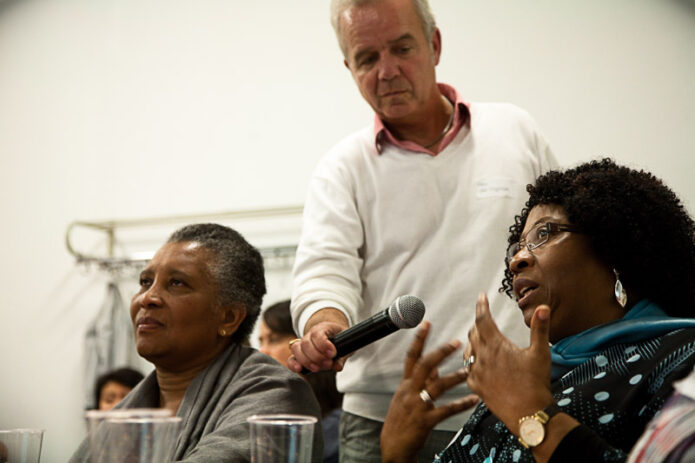 Poster: Wij en de Wereld – Popular cultural portrayals of the Surinamese: 1873-2013 exhibition
Poster: Wij en de Wereld – Popular cultural portrayals of the Surinamese: 1873-2013 exhibition Screening and Talk: Us and the World - multiple perspectives in the portrayal of the Surinamese: 1873-2013
2013 marks the 150-year abolition of slavery by the Dutch in their colony of Surinam. A little known fact is that the in 1863, the former slaves were forbidden to leave the plantation of their masters. A caveat in the abolition decreed that ex-slaves were to continue working the plantations for another 10 years, albeit for minimal wages. Part Western civilizational rhetoric and part concession to the Dutch planters, it afforded them time to solve the predicted labour shortage that would arise as the erstwhile slaves were expected leave the plantations for the city of Paramaribo; an incorrect assumption as it turned out. As 1873 finally rolled around, the Dutch colony found itself in the process of a drastic change in its ethnic make-up. Turning to the English format of indentured labour, the Dutch imported sizeable groups of destitute and hopeful labourers from the Dutch East-Indies (Java, Indonesia), Manchuria (China) and British India (Bihar, Uttar Pradesh), promising good wages, housing and ultimately; prosperity.
In Wij en de Wereld: multiple perspectives in the portrayal of the Surinamese: 1873-2013, Anthropologists in Art delve into the period following the abolition of slavery, roughly from 1873 to the present. AiArt’s point of departure is how Surinamese society has been represented and has reinvented itself as the more recent arrivals of Javanese, Chinese and British-Indians (Hindoestani) negotiated a place for themselves amongst the colony’s earlier inhabitants (Amerindians, Maroons, Creoles, Jews and ethnic Dutch). In what must have been a dramatic social and ethnic shift within the colony, it forms the basis of the independent republic of Suriname today.
Instead of taking focal points in Suriname’s history as a means of exemplification, AiArt have decided instead to focus on several popular cultural media, showcasing various visual and textual portrayals of the Surinamese people within the history of this former Dutch colony, as it developed from a slave-colony to the independent country it is today. Largely indebted to Bibliotheca Surinamica’s (accessible through the website www.buku.nl by Carl Haarnack) vivid collection, AiArt have taken the popular cultural media of the postcard, the magazine and the music video clip (mostly from the srananpoku.org website) as the nodal points of investigation. Starting from photographic and illustrative documentation from the end of the 19th and beginning of the 20th century, many different series of postcards were produced and sold representing the various ethnic groups in the para-scientific manner of categorisation that was so much in vogue at the time. Continuing, the Afro-American emancipatory ‘Ebony’-magazine published a vivid reportage in 1968 of a multi-racial paradise, focussing on the beauty of Suriname’s bikini-clad girls. Lastly, AiArt turn to music video-clips, largely produced by and for the Surinamese community (within Suriname itself as well as the Surinamese diaspora), that showcase how contemporary youth choose to represent themselves to themselves and the world at large.
In a bid to counter over-simplifications in popular conceptions of history, Anthropologists in Art have decided to present fragmentary, multi-layered visual and textual representations of Suriname’s historical ethno-genesis.
As part and parcel of the Wij en de Wereld – Popular cultural portrayals of the Surinamese: 1873-2013 exhibition, AiArt, in conjunction with cultural analyst Marie Bromander, BukuBooks Bibliotheca Surinamica and Professor of Cultural Anthropology Alex van Stipriaan (Erasmus University Rotterdam & Tropenmuseum curator), have created a film programme and discussion-afternoon (ScreenTalk) that aims to deepen the understanding of the ethno-historical development of this fascinating country.
Screened movies during ScreenTalk
De Laatste Kantraki (dir: Ramdjan Abdoelrahman),
Back to the Roots (dir: Alex van Stipriaan / Dineke Stam)
SAAMAKA (dir: Karl Doing).
ScreenTalk Participants
Alex van Stipriaan (Professor of Cultural Anthropology & Curator Tropenmuseum, Caribbean and Latin America)
Britt-Marie van der Drift (MSc Cultural Studies)
- ANTHROPOLOGISTS IN ART
Links
Caribbean / Slavery / Suriname /
Network
